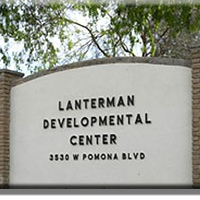Developmentally Disabled Center Closes as State Embarks on Precarious New Care Path

You would hardly know from Googling “Lanterman Developmental Center” for postings in the last year that the end of an era approached and the lives of hundreds of seriously disabled people were radically changing—not always for the better and often shrouded in uncertainty. It doesn’t turn up a lot of hits.
More than 14,000 people who have profound or serious developmental disabilities, like cerebral palsy, epilepsy and autism, have lived at Lanterman in Los Angeles County since its founding as the Pacific Colony and State Narcotics Hospital for the “feeble-minded” in 1927. But the last of its residents will be gone by New Year’s, four years after the state announced its closure date, and the rest of the public facilities like it are quickly winding down.
For the most part, the residents are being moved to group homes, where the aim is to offer mainstream community integration rather than segregation in larger settings.
Supporters regard it as a cost-effective way to continue down a path from virtual imprisonment to integration, begun 45 years ago when state lawmakers passed the Lanterman Developmental Disabilities Services Act. The legislation guaranteed the developmentally disabled basic rights of support, established a network of developmental centers to house and provide services to thousands, and fostered the community-based system.
Institutions like Lanterman were cutting edge when created by the state in the late 1960s.
In 1968, there were 13,300 residents in the network. That dropped to 5,713 in 1994 and only 1,159 remained as of November 26. About a third of them are at the Sonoma Developmental Center, which lost federal funding last year for deficiencies. Lanterman, which had 2,000 residents in 1970, becomes the third of seven to close.
The centers have come under attack for more than a decade over a lack of security that endangered patients, employees and visitors. A 2002 report from the California Attorney General said the health care staff, as well as the security forces, were overworked, underfunded and ill-prepared. The California State Auditor reported in 2013 that many of the 28 reforms recommended by the AG had gone unattended to.
Critics complain that the state is abdicating responsibility for its most vulnerable residents by placing more of their care in private, for-profit hands, rather than funding improvements and managing the facilities better.
The Los Angeles Times led its story about Lanterman this week with an anecdote about a 50-year-old resident who successfully transitioned to a group home, pleasantly surprising his skeptical family. It closed the story with the family and had nothing bad to say in between.
Mary O’Riordan, past president of the Parent Hospital Association at Sonoma Developmental Center, fills in some of the gaps with a discouraging word or two in an April 10 comment on a story reprinted from the Pasadena Star-News. O’Riordan wrote:
“Let’s stop the lies about the closure of these treatment facilities. The successes we hear about are just a few developmentally disabled people who are not so seriously disabled or do not have dangerous behaviors. . . . The developmental centers are needed as there is no other safety net—prisons and nursing homes are not an option. Please stop listening to those who benefit from the privatization of these services.”
–Ken Broder
To Learn More:
An Era Comes to an End as Pomona's Lanterman Center for Disabled Closes (by Tre'vell Anderson, Los Angeles Times)
Treatment in Transition: A Look at the Closure of Lanterman Developmental Center (by Lauren Gold, Pasadena Star-News)
11 Years Later, Disabled Patients Still at Risk in Underfunded Developmental Centers (by Ken Broder, AllGov California)
- Top Stories
- Controversies
- Where is the Money Going?
- California and the Nation
- Appointments and Resignations
- Unusual News
- Latest News
- California Forbids U.S. Immigration Agents from Pretending to be Police
- California Lawmakers Urged to Strip “Self-Dealing” Tax Board of Its Duties
- Big Oil’s Grip on California
- Santa Cruz Police See Homeland Security Betrayal in Use of Gang Roundup as Cover for Immigration Raid
- Oil Companies Face Deadline to Stop Polluting California Groundwater





